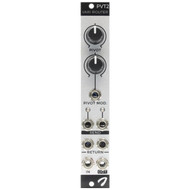Pivot 2 - Joranalogue
by Jason Czyeryk
When I think of the word pivot, I always think of a specific scene in the movie Million Dollar Baby where the narrator is describing boxing mechanics, specifically how a boxer moves left and right while maintaining their balance and keeping their core strength intact. It’s a beautiful shot, a close up of a leg in a boxing shoe pivoting (naturally), and the image defines one meaning of the word to me, and the brief cinematic instance has lent a certain lasting amount of grace to the word.
Not that Joranalogue modules are in need of extra gravitas, but the well-named Pivot 2 perked my ears from the start. Just like a boxer, Pivot 2 is about movement as well, and is an analog CV or audio signal router that has a send and return loop that can both be used in series, reverse series, or parallel. One of the many things I like about Joranalogue modules is that they can make something that would normally be a utility, somewhat mundane even, and give it a very usable twist, usually unique to them. Pivot 2 is no different, and while its function is pretty simple—patch a signal into the Input and have it routed to either of the Send/Returns or both and bring it back to its respective input—how it does this is what really makes it stand out.
There’s an Input and an Output with two sets of Send/Return channels; a Left channel, and a Right channel. There’s also a knob for Pivot, and another knob, which is an attenuverter, for Pivot Modulation amount. Depending on the Pivot knob position, the input flows from one Send/Return into the next, so with the Pivot knob fully CCW, the Left side is normalled in series into the Right side’s Input. If you turn the knob fully CW, then it reverses and the Right channel flows into the Left. A centered knob gives a 50% ratio between the two sides/channels for a parallel routing situation. It’s a pretty clever way to go about doing all of this, and actually quite convenient. Being able to audition signal chains, including the in-between positions, not just the more absolute signal paths, and being able to modulate this is signal routing nirvana.
Changing the routing between two parameters without the need to patch/repatch is a dream. It’s one thing to see if delay always sounds better going into reverb as opposed to the other way around, and completely another to hear the difference from having a signal go into a wavefolder before another wavefolder, have that second wavefolder go first in the chain, or have them in parallel, all just by twisting a knob, and to be able to adjust the balance of the two. Sometimes when I’m processing a bassline through two separate distortions, with one feeding the other, it’s hard to dial in the right amount to hit the sweet spot of the first in order to feed the second and get its sweet spot, and Pivot 2 makes it pretty easy to do this. It seems like it would be similar to attenuating the signals, but it produces a totally different result than doing that, and being able to hear the two distortions in parallel, or switching the order of the two was really helpful in finding what I was looking for and being able to dial it in. Most of the time it was just confirming the order I already knew worked best, but not always, and there were some surprises that were easily achieved because the functionality of Pivot 2 made it so.
Outside of the utilitarian use cases that I used Pivot 2 for, there are some—what I’d call tricks—you can do as well, like patching in CV and using Pivot 2 as a dual ping-pong VCA, which can act like both a VC panner and a VC crossfader, depending on what shape of CV you patch into it.
Even with something as everyday and utilitarian as signal routing, Joranalogue manages to bring something new to the table with Pivot 2 and rises above the rest.
4 HP +12v 60mA -12v 60mA
Price: $160


